Various engaging fine motor activities for home and classroom use include fruit peeling, creative use of kitchen utensils, crafting with recycled materials, paper-centric exercises, and innovative exercises with household tools. Activities like these enhance hand-eye coordination and precision and promote essential skills like writing, self-care, and problem-solving. Simple games involving materials like straws or rubber bands, painting, or cup stacking encourage hand-eye coordination and precision. The inclusion of safety precautions guarantees these activities can be performed confidently. Discover the full potential of these activities when you continue to explore their practical applications.
Key Takeaways
- Peeling fruits such as grapes, clementines, and bananas can enhance fine motor skills, such as finger movements and precision.
- Using kitchen utensils such as tongs, spoons, and whisks in fun activities can improve grip strength, control, and rotational wrist movements.
- Crafting with recycled materials like paper and plastic straws can promote hand strength, precision, and hand-eye coordination.
- Paper-centric exercises like tearing, creasing, cutting, and pasting improve hand muscle strength, fine motor control, and creativity.
- Using standard household tools like tongs, cotton balls, and popsicle sticks creatively can help children develop precision, hand-eye coordination, and fine motor skills.
Understanding Fine Motor Skills
As we delve into fine motor skills, we must understand that these involve the coordination of small muscles in the hands and fingers, primarily used for writing, cutting, and holding small objects. Developing these skills is vital during preschool and kindergarten, forming the foundation for daily activities like self-care, school tasks, and play.
Fine motor skills are central to fostering hand-eye coordination, an essential aspect of overall talent. This coordination is the synchronized control of eye movement with hand movement and the processing of visual input to guide reaching and grasping.
Moreover, fine motor skills are essential for success in school and extend to future career tasks, emphasizing their long-term significance. As caregivers, educators, or therapists, understanding the role and development of these skills can help us devise effective strategies and activities to facilitate fine motor skills. Essentially, fostering fine motor skills is not just about enhancing a child’s ability to handle small objects but also about preparing them for a future of successful interactions with the world around them.
Safety Precautions for Activities
While promoting the development of fine motor skills through various activities, it is crucial to prioritize safety, especially when small objects are involved, as they could potentially pose choking hazards. To mitigate such risks, it is vital to supervise children closely during these activities. This ensures that children do not inadvertently place these small objects in their mouths, which can lead to choking.
Furthermore, it is advisable to avoid giving children unsupervised access to activities that involve small parts. If swallowed, such items can cause serious harm. Thus, safety measures and activities should be ensured under vigilant adult supervision.
Cutting them into smaller pieces is essential when using food items, such as grapes, for fine motor activities. This simple step dramatically reduces the risk of choking and allows children to engage in the activity safely. Remember, safety is not just a precaution but a responsibility when organizing fine motor activities for children. A safe environment promotes confidence in children and encourages them to explore and enhance their fine motor skills without fear.
Fruit-Based Fine Motor Activities
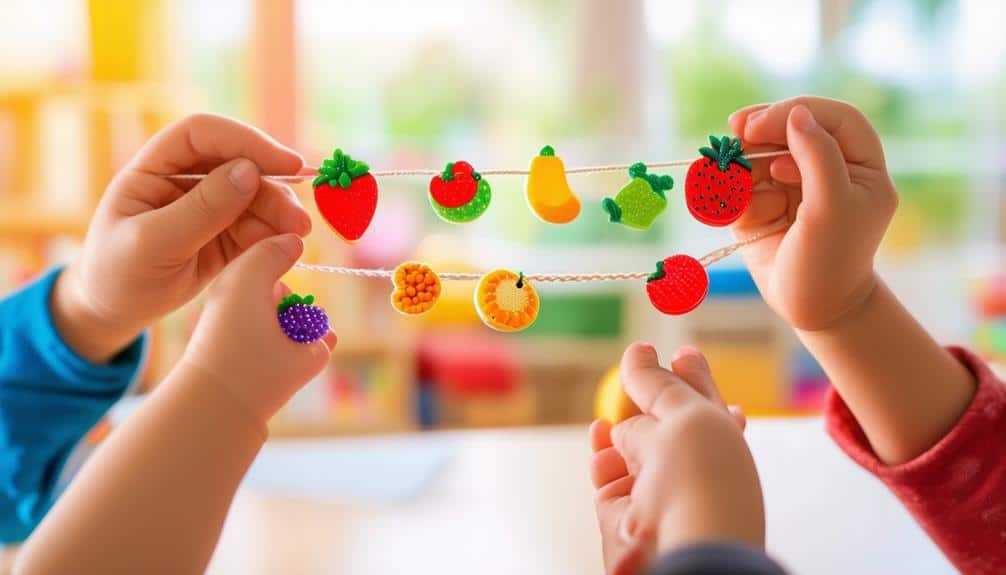
Numerous fruit-based activities can be an exciting and beneficial method for enhancing fine motor skills in children. They provide an interactive, engaging experience that promotes finger strength, talent, and essential daily task skills.
Motor Activities for Preschool often incorporate playful elements for skill development. For instance, peeling grapes, clementines, and bananas introduces children to healthy foods and allows them to practice precision in finger movements. Peeling requires a pincer grasp, an essential skill for writing and manipulating small objects.
Similarly, twisting open small fruit containers or zipper snack bags offers another practical, hands-on approach to building fine motor skills. These activities foster hand-eye coordination, an ability critical in performing daily tasks efficiently.
Furthermore, executing these fine motor activities throughout the day can seamlessly integrate into your child’s routine. These activities do not require special equipment or materials, making them feasible options for home and classroom settings.
Using Household Items Creatively
Turning our attention towards the creative use of household items, we can explore numerous practical activities that engage young learners and enhance their fine motor skills. Fun with Kitchen Utensils, Recycled Material Crafts, and Everyday Object Challenges offer a variety of opportunities for children to learn and improve through play. These simple activities utilize everyday items around the home and classroom, making them accessible and cost-effective methods for fine motor development.
Fun With Kitchen Utensils
Engagingly and interactively, children can utilize everyday kitchen utensils, such as tongs, spoons, and whisks, to participate in fine motor activities that promote the development of hand strength, coordination, and agility. Often found in the home, these items provide an excellent source of fun while building dexterity and hand-eye coordination. This practical approach to skill-building can be seamlessly incorporated into daily routines, making it an ideal solution for parents and educators.
Tongs, for example, can be used to pick up small objects, enhancing grip strength and precision. Spoons can transfer items from one bowl to another, facilitating better control and coordination. On the other hand, whisks can be utilized in a bowl of dry beans or rice, promoting rotational wrist movements, an essential pre-writing skill.
Recycled Material Crafts
Harnessing the potential of ordinary household items, recycled material crafts offer an innovative and eco-friendly approach to improving fine motor skills in children. These activities engage children in creative play while simultaneously developing their hand strength and precision.
- Repurposing Old Paper: Children can tear and crumple old paper, promoting both hand strength and precision. This simple activity also encourages them to think creatively about reusing materials.
- Cutting Plastic Straws: Children can develop their fine motor skills using recycled plastic straws for cutting activities. This activity enhances precision and strengthens the small muscles in their hands.
- Homemade Playdough: Creating playdough from pantry items is eco-friendly and an excellent way to enhance fine motor skills. Children can shape and mold the dough, refining their hand-eye coordination.
- Transforming Old Containers: Old containers can be converted into twist-open snack holders. This activity helps improve coordination and hand strength as children twist the container open and close.
Everyday Object Challenges
How can we creatively incorporate everyday household items such as straws, tennis balls, and cotton balls into engaging activities that foster fine motor skills in children? The answer lies in the everyday object challenges, an innovative approach to fine motor activities at home and in the classroom.
These challenges involve using everyday household items in fun and interactive ways to promote hand strength and agility. For instance, children can enhance their fine motor skills by cutting straws, twisting tennis balls, or peeling bananas. Such activities provide strong fine motor skills training and stimulate creativity and problem-solving abilities.
Below is a table demonstrating some everyday object challenges:
| Object | Activity |
|---|---|
| Straws | Cutting |
| Tennis Balls | Twisting |
| Cotton Balls | Picking up with Tweezers |
| Bananas | Peeling |
To successfully serve others, especially the children in our care, we must creatively use the resources around us. Everyday object challenges offer a practical, cost-effective, and enjoyable strategy for developing children’s fine motor skills and preparing them for tasks that require precision and coordination.
Paper-Centric Fine Motor Tasks
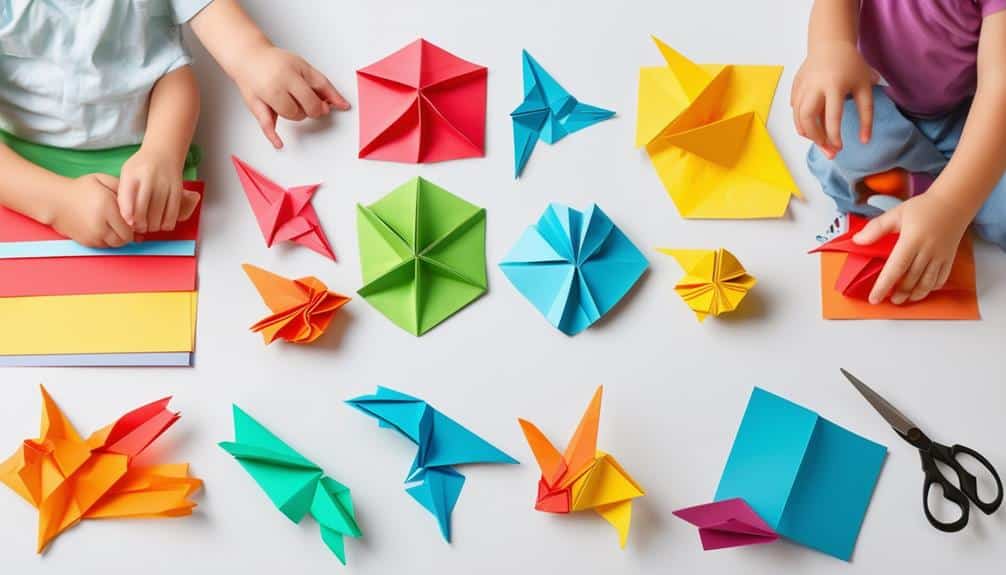
Delving into paper-centric delicate motor tasks, these activities leverage everyday household items to build strength and coordination in a fun and engaging manner. These exercises primarily utilize paper and can significantly enhance fine motor strengthening and cutting skills, even in the comfort of one’s home.
- Tearing Paper: Tearing paper into small pieces provides a simple yet effective method to strengthen hand muscles and promote bimanual tripod grasp. This straightforward task can be more engaging by being turned into a creative project, such as a collage.
- Creasing Paper: Making paper airplanes or origami improves fine motor control and hand-eye coordination. These activities require precision and patience, teaching children the importance of concentration and diligence.
- Clothespins or Chip Clips can be used when hanging artwork, further improving fine motor skills and finger dexterity. Incorporating this activity into a race or a game can make it more exciting.
- Cutting and Pasting Pictures: Cutting pictures apart and then gluing them back together nurtures fine motor skills such as scissor control and hand-eye coordination and sparks creativity.
These paper-centric tasks are enjoyable and efficient in developing essential motor skills.
Tool-Involved Fine Motor Exercises
Incorporating tools in fine motor exercises can offer a multifaceted approach to developing essential skills in children. Each offers distinct opportunities for enhancing hand-eye coordination, hand control, and finger manipulation, from household tools such as tongs and screwdrivers to creative exercises involving pegboards and building blocks. This section will explore these tool-involved fine motor exercises, providing practical examples that can be easily implemented at home and in the classroom.
Activities With Household Tools
Exploring the realm of fine motor exercises, we can creatively utilize standard household tools like tongs, cotton balls, and popsicle sticks to enhance hand-eye coordination, precision, and hand strength in children. These tools are not only easily accessible but also versatile, adding a new dimension to fine motor activities at home.
Let’s dive into how these tools can be used:
- Tongs: Children can pick cotton balls and transfer them from one bowl to another. This activity aids in building finger strength and precision.
- Cotton Balls: Encourage children to push cotton balls through holes in a lid. This enhances their hand-eye coordination.
- Popsicle Sticks: Creating designs with these can improve both creativity and precision.
- Tennis Ball: Cutting a tennis ball to make a mouth for picking up small items is an engaging way to develop fine motor skills.
Tool-Dependent Creative Exercises
Building on the concept of using household tools, tool-dependent creative exercises introduce specific tools like scissors, tweezers, and pencils further to stimulate the development of fine motor skills in children. These activities, rich in exemplary motor engagement, are beneficial and offer a hands-on approach to skill development and creativity.
Scissors, for instance, are an excellent tool to enhance hand strength and coordination. Through cutting exercises, children learn to control the force they apply and the direction they move. This promotes precision, a crucial element of fine motor skills.
Tweezers, on the other hand, encourage finger isolation and bilateral coordination. Picking up small items with tweezers requires hand-eye coordination and finger dexterity that can significantly advance a child’s fine motor skills.
Pencils are another essential tool. Writing and drawing stimulate the small muscles in the hand, aiding in the development of precision and grip strength.
Skill-Enhancing Tool Usage
Various tool-involved exercises can be introduced to enhance children’s fine motor skills further. These exercises focus on using objects like pegboards, building blocks, tongs, scoops, hole punchers, and clothespins. Each tool offers unique benefits for muscle strength, coordination, and precision. These fine motor skill activities promote children’s physical development and contribute to cognitive and social growth.
Here are four practical ways to integrate these tools into children’s daily routines:
- Pegboards: These are excellent for developing hand-eye coordination. Children can insert pegs into different positions, enhancing their fine motor skills and spatial awareness.
- Building Blocks: Encourage children to stack blocks, strengthening hand muscles and precision. Varying the size and weight of the blocks can add an extra challenge.
- Tongs and Scoops: Incorporate these tools into play activities. Picking small objects with tongs or scoops improves fine motor control and precision.
- Hole Punchers and Clothespins: These tools can strengthen hand muscles and coordination. Simple tasks like punching holes or clipping clothespins can be fun and skill-enhancing for children.
Daily Objects for Skills Enhancement
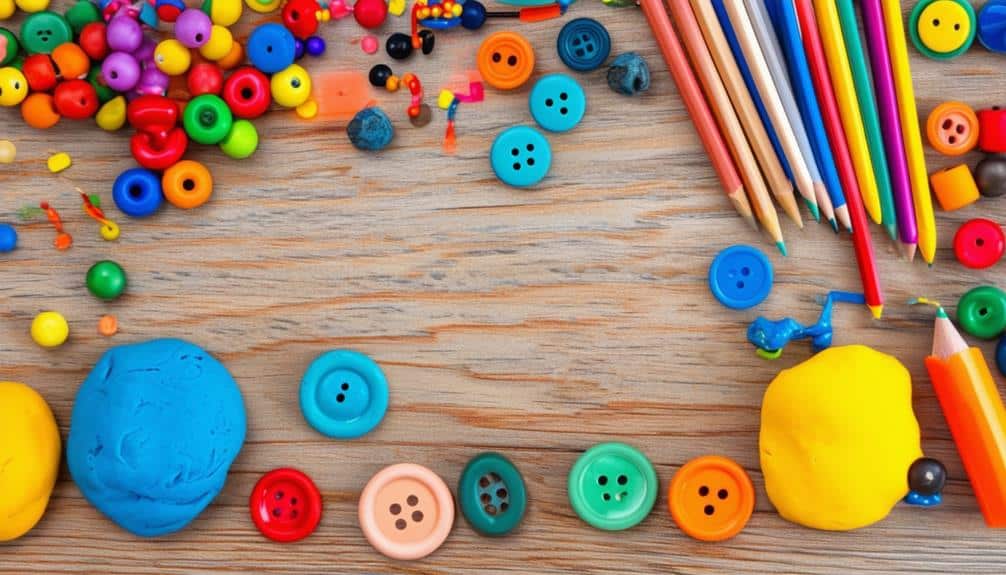
Regular interaction with everyday objects such as plastic straws, tennis balls, and cotton balls can enhance a child’s fine motor skills, promoting hand strength, finger dexterity, and coordination in home and classroom environments. This practical approach to fine motor development is both cost-efficient and accessible, making it an advantageous strategy for those in service roles such as teachers, therapists, and parents.
Creative motor skills activities using these everyday items offer a practical method to foster the coordination required in daily tasks. For instance, pinching cotton balls to transfer them from one container to another can strengthen finger muscles and improve precision. Similarly, manipulating a tennis ball can enhance hand strength and flexibility.
Incorporating these everyday objects into a child’s routine can also make learning fun and interactive, boosting their engagement and interest. The tangible connection to everyday items provides a context for skills development, assisting children in understanding the applicability of these motor skills in their daily lives.
Straw-Based Activities for Dexterity
Straw-based activities can offer a rich source of fine motor skill development. Activities such as cutting straws for jewelry, straw-based sorting games, and building with straws are engaging and greatly enhance hand-eye coordination and dexterity. This discussion will underline the practicality and effectiveness of these activities in promoting motor skills in both classroom and home settings.
Cutting Straws for Jewelry
Crafting colorful jewelry from cut straws fuels creativity and imagination in young minds. It provides a cost-effective, engaging exercise to enhance fine motor skills, hand dexterity, and hand-eye coordination. This cutting straw activity is one of the most effective fine motor skills, combining elements of precision, control, and creativity in an enjoyable exercise.
The process can be broken down into four simple steps:
- Selection: Choose a variety of colorful straws, encouraging children to express their creativity in their jewelry designs.
- Cutting: Using child-safe scissors, cut straws into various lengths. This reinforces the development of hand skill and precision.
- Threading: Thread the cut straws onto pipe cleaners or string. This step enhances hand-eye coordination and bilateral coordination.
- Designing: Encourage children to create patterns or specific designs, fostering their creativity and problem-solving skills.
Thus, cutting straws for jewelry-making is a fun and practical method to develop fine motor skills. It promotes creativity, offers a sensory experience, and allows children to practice their motor skills in a fun and engaging manner.
Straw-Based Sorting Games
Engaging in straw-based sorting games, where children sort objects by color, size, or shape using different colored straws, can significantly enhance their dexterity and hand-eye coordination. This acceptable motor activity requires children to use their pincer grasp to pick up and manipulate the straws, thus strengthening their fingers and improving precision.
These games are adaptable and versatile, suitable for various skill levels, from preschoolers to older children. The inherent simplicity of straw-based sorting games and their adaptability makes them a practical choice for educators and parents alike. They are a cost-effective method of promoting fine motor development and a tool to cultivate a child’s cognitive abilities, such as their understanding of colors, sizes, and shapes.
Straw-based sorting games present an exciting opportunity to integrate playful learning and skill development. By performing these hands-on tasks, children can further enhance their hand-eye coordination in a fun, interactive, and engaging way. Hence, this game is an effective and enjoyable means to foster the essential fine motor skills children require for their critical developmental stages.
Building With Straws
Incorporating straw-based activities into a child’s routine can be an innovative and effective strategy for enhancing fine motor skills, especially talent. This motor skill activity improves hand-eye coordination and provides a fun, engaging, and interactive platform for learning.
- Straw Cutting: Provide the child with small plastic straws and safety scissors. The activity involves cutting the straws into small pieces, which can be used for sorting or crafting. This action strengthens the hand muscles and develops precision and control.
- Straw and Tennis Ball Activity: Feeding a tennis ball with small straw pieces from a cut mouth is an enjoyable dexterity task. This activity enhances the child’s pincer grip and promotes the development of fine motor skills.
- Pipe Cleaners and Straws: Threading pipe cleaners through straws is an activity that promotes focus, precision, and hand strength.
- Straw Construction: Encourage the child to construct structures using straws and connectors, like playdough or marshmallows. This activity fosters creativity while simultaneously strengthening fine motor skills.
Children can enjoy these activities while developing their dexterity and fine motor skills.
Rubber Band Games for Coordination
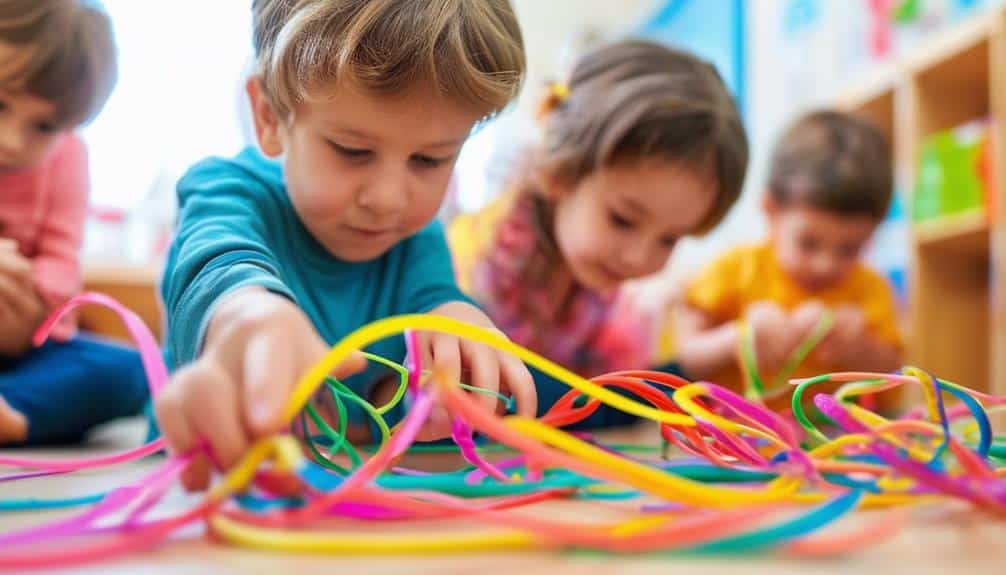
Using rubber bands’ simple flexibility can offer various opportunities to enhance children’s coordination and fine motor skills. Rubber band games, if integrated thoughtfully, can be fun and engaging to promote finger dexterity and hand strength. These games use the resistance of the rubber bands as a tool for muscle development, thereby enhancing coordination.
One practical activity involves stretching rubber bands around the fingers. This resistive activity strengthens the hand muscles and improves the child’s understanding of how their fingers can move and work together. Another effective rubber band game is placing bands around a container and encouraging the child to remove them. This challenges their hand-eye coordination and nurtures their fine motor skills.
Incorporating these rubber band games into your daily routines can help children develop crucial skills in a playful, stress-free manner. These activities serve the purpose of skill development and allow children to explore their abilities, improve their confidence, and achieve a sense of accomplishment. Therefore, rubber band games can be a powerful tool for enhancing children’s coordination and fine motor skills.
Sponge Painting for Tripod Grasp
Sponge Painting for Tripod Grasp is an engaging and effective method for developing and enhancing fine motor skills in children. Children can practice the tripod grasp by exploring various sponge-cutting techniques, which are fundamental for holding writing tools. Painting with sponges and using them in toy cleaning activities can further improve children’s hand-eye coordination and finger dexterity.
Sponge Cutting Techniques
Sponge-cutting techniques can enhance a child’s tripod grasp and fine motor skills. These techniques involve slicing sponges into 1-inch pieces for painting activities. Cutting sponges fosters hand strength and precision in cutting skills and promotes hand-eye coordination.
- Choosing the Sponge: Select a sponge that’s easy to grip. It should be firm enough to hold its shape when cut yet soft enough to be sliced easily.
- Slicing the Sponge: Teach children to cut the sponge into 1-inch pieces safely. This activity promotes the tripod grasp, as children have to hold the cutter in a pincer grip.
- Texture Creation: The cut sponge pieces can create distinctive textures and patterns in art projects, stimulating children’s sensory skills.
- Supervision and Safety: Always supervise children while they are cutting sponges. Guarantee that they use safe tools and are not at risk of injury.
Painting With Sponges
Engaging children in sponge painting activities offers a fun and creative outlet and dramatically enhances their fine motor skills, particularly the crucial tripod grasp needed for writing and drawing. Children are encouraged to hold and manipulate the sponge with their fingers by painting with sponges, improving their fine motor control.
Cutting sponges into small, manageable 1-inch pieces can increase the precision and coordination required in this activity. The child’s fingers must hold the sponge, dip it into the paint, and then apply it to the paper. This demands significant fine motor control and strengthens the hand muscles necessary for the tripod grasp.
Sponge painting also provides a rich sensory experience. The sponge’s texture, the paint’s smoothness, and the visual outcome all contribute to a dynamic sensory activity. This offers a creative way to develop fine motor skills while allowing children to express themselves through art.
Toy Cleaning Activity
Incorporating a playful element into learning, the toy cleaning activity utilizes small, 1-inch pieces of sponge to paint and clean toys, thereby promoting the development of fine motor skills, hand-eye coordination, and the essential tripod grasp. The tactile experience of sponge painting enriches sensory integration and sparks creativity in young learners, a crucial component of their overall cognitive development.
To implement this activity, the following steps can be followed:
- Cut sponges into 1-inch pieces. This size encourages precise finger movements, which is beneficial for developing fine motor skills.
- Introduce the child to the activity. Start with sponge painting before shifting to the toy cleaning activity. This can be a fun way for children to learn to care for their toys while developing essential skills.
- Guide the child to hold the sponge piece in a tripod grip, similar to how one would have a pencil. This promotes the proper grip needed for writing.
- Allow the child to engage freely, but assist when necessary. Remember to maintain a fun and engaging atmosphere to keep the child interested.
Cup Stacking for Control

Cup stacking, an enjoyable and interactive activity, offers a unique approach to improving children’s hand-eye coordination and fine motor control. This task requires precision and graded control, making it challenging yet rewarding. By stacking plastic or paper cups in various patterns or sequences, children can enhance their hand and finger strength while honing their fine motor skills.
In addition to physical benefits, cup stacking promotes concentration, problem-solving abilities, and spatial awareness. These cognitive skills are as necessary for a child’s development as fine motor skills, making this activity doubly advantageous. Moreover, it can be adapted to suit different skill levels and ages, making it a versatile choice for home and classroom use.
Dismantling Devices for Precision
While it might seem nontraditional, dismantling broken electronic devices with a screwdriver can be an enriching, hands-on activity that significantly enhances a child’s fine motor skills. This innovative approach requires precision and coordination to disassemble the intricate components of the devices successfully.
Engaging in such activities allows children to develop:
- Hand Strength: Handling a screwdriver and other tools to dismantle devices helps strengthen the hand muscles.
- Finger Dexterity: Precision is needed to unscrew small screws and handle tiny components, which improves finger dexterity.
- Problem-Solving Skills: Understanding how to dismantle a device in the correct order promotes logical thinking and problem-solving skills.
- Technological Curiosity: Exploring the inner workings of a gadget can spark an interest in technology, fostering curiosity and learning.
Dismantling devices offer an innovative yet effective avenue for children to explore their motor skills. It’s a practical, hands-on way to develop fine motor skills while providing an interactive learning experience. Safety is paramount, so ensure children are supervised during these activities. Children can learn, grow, and thrive in their development with precision and coordination.
Nut and Bolt Coordination Exercises
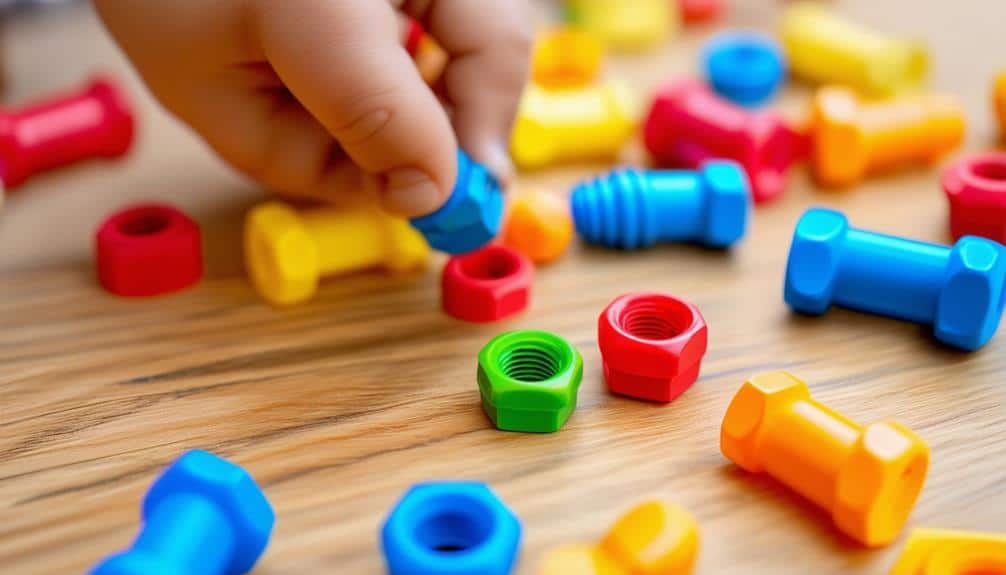
The world of nut and bolt coordination exercises offers many opportunities for children to enhance their fine motor skills and hand-eye coordination. These fine motor activities involve twisting nuts onto bolts, requiring children to use precision and control. In doing so, they exercise their small hand muscles and improve grip strength, which will serve them well in various aspects of life, such as writing or tying shoelaces.
Furthermore, nut-and-bolt exercises can be utilized for color pattern activities. This aspect not only enhances visual perception but also promotes concentration and focus. Aligning a specific colored nut with its corresponding bolt demands attention and persistence, fostering a patient and systematic approach in children.
Moreover, these exercises are instrumental in developing problem-solving skills. Children learn to determine which nut fits onto which bolt, maneuvering size, shape, and thread differences. This encourages them to think critically, make decisions, and learn from trial and error.
Vacuuming and Painting Activities
Shifting our focus to vacuuming and painting tasks, these engaging assignments provide a rich platform for developing children’s fine motor skills, fostering creativity, and enhancing hand-eye coordination.
- Handheld vacuuming is a simple yet effective acceptable motor activity at home. This task promotes hand strengthening and coordination, which are crucial for tasks such as writing. Children can vacuum small messes or specific areas to make this activity more manageable and fun.
- Squirt bottle painting is a delightful outdoor painting activity. It requires the child to control the pressure and direction of the squirt bottle, enhancing hand-eye coordination and fine motor skills. Plus, it’s an excellent avenue for children to express their creativity.
- Sponge painting with cut sponges is another painting activity that enhances fine motor skills. It strengthens the tripod grasp and finger control, which are critical for writing and drawing.
- Rubber band activities, like stretching and placing them around containers, provide resistive fine motor exercises. These activities offer children an opportunity to develop finger strength and agility.
Incorporating these vacuuming and painting tasks into children’s routines can significantly foster their fine motor skills development, mainly when performed regularly and enthusiastically.
Frequently Asked Questions
How Can I Practice Fine Motor Skills at Home?
To practice fine motor skills at home, incorporate activities like peeling fruits, twisting containers, and bead stringing. Use tools such as tongs and clothespins, and encourage paper tearing, cutting, and gluing for hand strength.
What Activities Promote Fine Motor Skills?
Activities promoting fine motor skills include threading beads, cutting with scissors, puzzles, lacing cards, playdough sculpting, sorting buttons, sticker art, stacking cups, tearing paper, and pouring and transferring objects. These aid in hand-eye coordination and finger dexterity.
How Do You Develop Fine Motor Skills in the Classroom?
To develop fine motor skills in the classroom, implement activities involving cutting, pasting, tracing, and using scissors. Incorporate manipulatives, puzzles, blocks, threading, lacing, beading, sensory bins, and playdough to enhance coordination and tactile perception.
How Do You Accommodate Students With Fine Motor Skills?
Implement assistive tools like pencil grips, adapted scissors, and technology aids to accommodate students with fine motor skills. Encourage sensory breaks and tailored instruction, and collaborate with occupational therapists for customized strategies and accommodations.
Conclusion
Essentially, the significance of fine motor skills cannot be emphasized enough. These skills can be improved through innovative methods like fruit manipulation, creative use of household items, paper activities, stacking cups, disassembling devices, coordination drills, and even vacuuming or painting. The intrinsic importance of these tasks in refining such abilities while offering an enjoyable experience highlights the need to integrate them into domestic and educational settings, accentuating the significant impact of fine motor activities on growth and education.

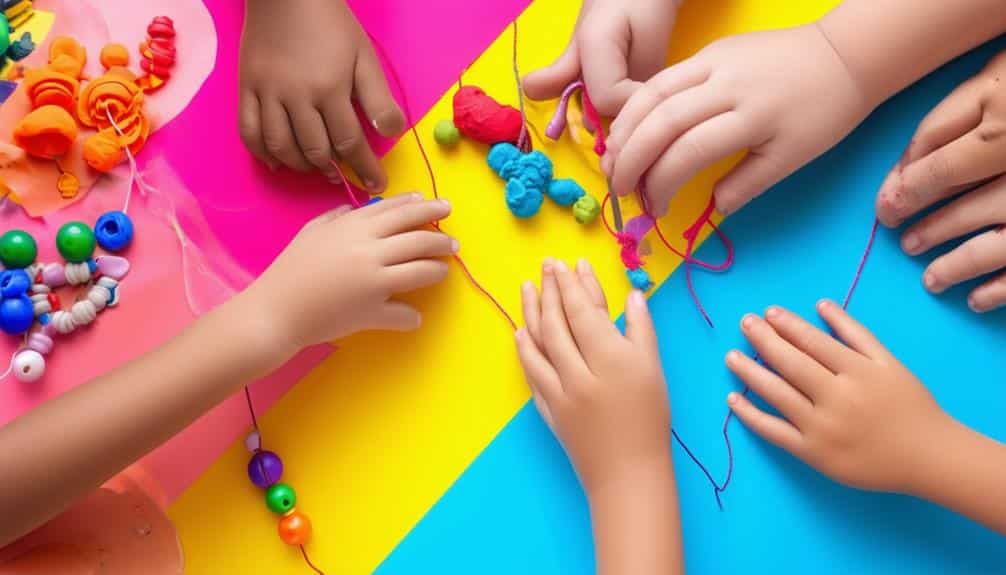
Recent Comments